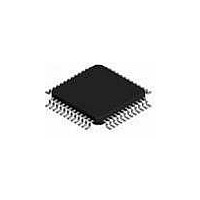WM9705SEFT/RV Wolfson Microelectronics, WM9705SEFT/RV Datasheet - Page 48

WM9705SEFT/RV
Manufacturer Part Number
WM9705SEFT/RV
Description
Audio CODECs Stereo AC'97 Codec T/P Interface
Manufacturer
Wolfson Microelectronics
Datasheet
1.WM9705SEFTV.pdf
(55 pages)
Specifications of WM9705SEFT/RV
Number Of Adc Inputs
1
Number Of Dac Outputs
1
Conversion Rate
48 KSPs
Interface Type
AC97
Resolution
12 bit
Maximum Operating Temperature
+ 85 C
Mounting Style
SMD/SMT
Package / Case
TQFP-48
Minimum Operating Temperature
- 25 C
Number Of Channels
2 ADC, 2 DAC
Lead Free Status / RoHS Status
Lead free / RoHS Compliant
WM9705
PRESSURE MEASUREMENT
w
BUSY SIGNAL
The BUSY signal is derived from the pen state machine and is an indication of the AUXADC
being active on a conversion cycle. When an AUXADC conversion is requested BUSY will go high
61 BCLKs after the rising edge of SYNC in the frame that the conversion was requested. BUSY
will remain high until the data from the conversion is written into register 7A as the state machine
sees the register write as the last stage of the conversion.
During a conversion that does not have the WAIT bit set, the BUSY negative pulse between
conversions (signifying data written to Reg 7Ah) lasts 3 BCLKs and starts 11 BCLKs before the
next rising SYNC edge. At the end of a conversion (or set of conversions) BUSY goes low 11
BCLKs before SYNC rises.
The WAIT bit instructs the device to wait until the previous conversion result has been read from
register 7Ah before overwriting it. Without this bit set conversion results are not held. During a
multiple conversion cycle in which WAIT is set the busy signal may operate differently. If the
device it set to perform 3 simultaneous conversions with WAIT set the timing of busy is
dependant on when the results are read from register 7A. If at the end of conversion 2 the result
from conversion 1 has not been read from the register the conversion sequence can not
complete. In this case BUSY will remain high until 61 BCLKs after the rising SYNC edge at the
beginning of the frame in which register 7A was read. However if the result is read from register
7A before the end of conversion 2 the busy signal will operate as described in the paragraph
above.
In the case of single conversions with WAIT set the operation of BUSY would be the same as that
described above if the data was not read from Reg 7Ah before the next conversion requested had
completed.
Pen pressure is implied by determining the resistance between the two plates.
Pressure measurements are sometimes used to determine whether the pen is in contact with the
screen. However in this system the pen-down detect method is a far less power hungry way of
determining whether the pen is ‘down’ as it does not require continuous driving of the screen and
ADC conversions. This has the supplemental benefit of minimising audio signal interference. Pen
pressure measurements may be made if required, perhaps for reasons other than simply
determining pen-down.
This is done by injecting a known current into one end of one of the two plates (Y+), and
grounding one end of the other plate (X-). Then the voltage at the other two plate terminals is
converted (Y- and X+), the difference being a direct measure of the injected current value
multiplied by the Pen contact resistance. Figure A4 shows this schematically.
Requesting a pressure measurement automatically initiates a pair of conversions, the difference
in conversion values being returned as the pressure measurement. Delay between switching the
appropriate screen and ADC mux switches, and performing the conversions, is set in the DEL[3-
0] registers.
Figure 24 Pressure Measurement
Xswn
X-
Rpen
Yswp
Yswp
Y+
Prsw
X+
Y-
MXyn 2nd conv
MXyp 1st conv
Ipress
Vrswyp
Vrswxn
converter
A/D
Vrswan
Vrswap
PD Rev 4.5 July 2008
Production Data
48











